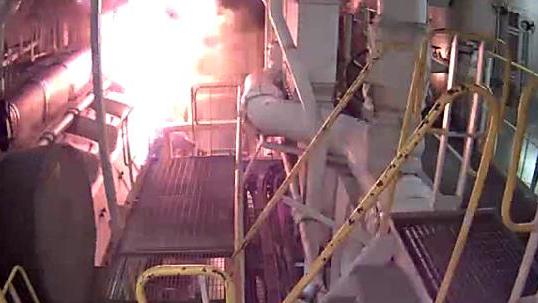Loose Bolts Caused Fire on Carnival Liberty

The U.S. National Transportation Safety Board (NTSB) has determined the probable cause of the engine room fire on the Carnival Liberty: improperly tightened bolts on a fuel inlet flange.
On the morning of September 7, 2015, the Liberty was alongside at the Charlotte Amalie cruise terminal on St. Thomas, U.S. Virgin Islands. At 1133 hours, fuel pressure alarms and fire alarms went off for the Liberty's #4 diesel generator, located in the aft engine room. The third engineer activated the space's HI-FOG fire suppression system within one minute of the alarm, and the second engineer switched the ship's electrical load over to the #2 generator, which is located in the ship’s forward engine room. Shortly thereafter, the chief engineer arrived at the control room and authorized the closure of fuel and lube oil shutoff valves for generators #4-6. By 1137, the engineering team had also closed off fans and dampers to the aft compartment.
The master was notified of the fire, and as a precautionary measure he ordered passengers to disembark onto the pier. He called for the chief engineer to muster and account for all engine room personnel, and once a head count for engineering crew was complete, he authorized the use of the CO2 fire suppression system, which successfully extinguished the blaze. By 1236, temperature readings on the outside of the compartment's watertight doors indicated that the fire was extinguished.
NTSB determined that the fire originated from a leak at the fuel supply inlet flange for a fuel injection pump. One bolt was missing and one more was loose, and investigators found the lost fastener below in the gallery for the cylinder bank. Laboratory analysis found nothing wrong with the bolts, and NTSB concluded that the probable cause of the fuel leak was improper tightening.
 The fuel injection pump; improperly tightened flange is just below center (NTSB)
The fuel injection pump; improperly tightened flange is just below center (NTSB)
While the engineering crew's response was rapid, NTSB noted that the team was not aware of the limitations of the HI-FOG system, which was only rated to supply water mist to one compartment at a time. The third engineer activated it for both compartments, leading to low water pressure at the discharge heads. The agency also noted a number of equipment malfunctions: the hydraulically-actuated valve to divert the CO2 stream to the aft compartment malfunctioned, requiring manual intervention; and the integrated emergency display screen on the bridge froze, forcing crew to rely on multiple sources to evaluate and respond to the situation.
Further, NTSB detailed problems that the crew encountered with mustering and accounting for passengers on the dock. At the time of the fire, many of the passengers were on shore, and the crew had to subtract this group from the full passenger manifest to create a muster list of those still on board. Even once this adjusted passenger manifest was ready, the scene on the pier created a difficult situation for getting an accurate head count: passengers who were already ashore at the time of the fire trickled in to join the evacuees, while some of the evacuated passengers wandered away from the muster areas. The crew swept the ship and made sure that no one remained aboard, but the confusion made it hard to verify that all passengers who had been on the ship were present on the dock.
In conclusion, NTSB called on Carnival to develop specific procedures for handling passenger evacuations when in port, and it recommended familiarization training on water-based fixed firefighting systems for Carnival’s engineers.
